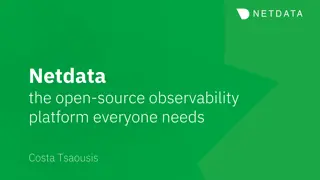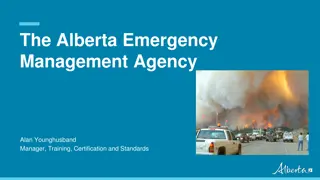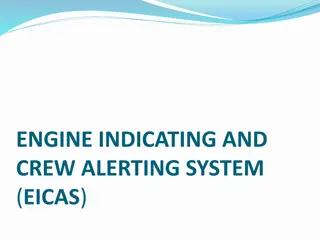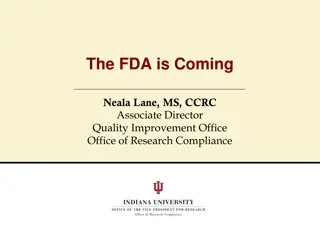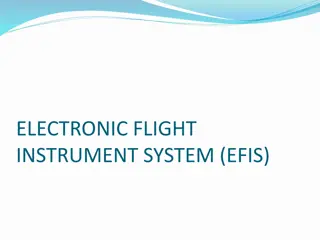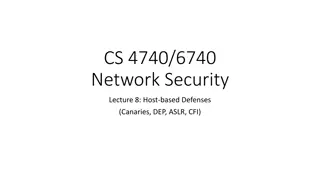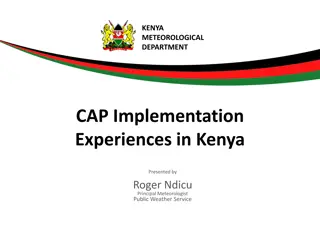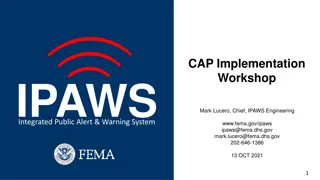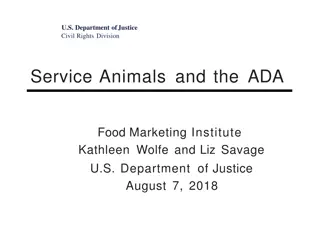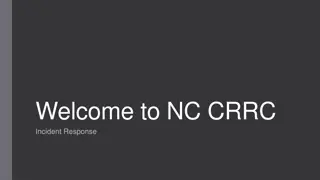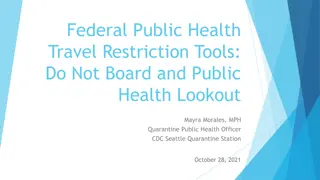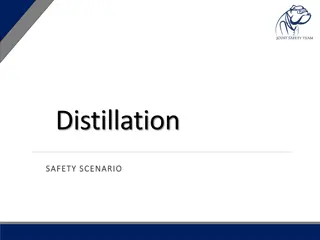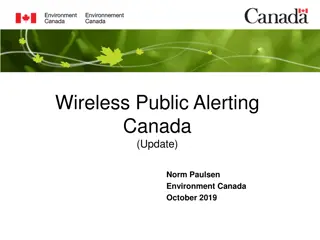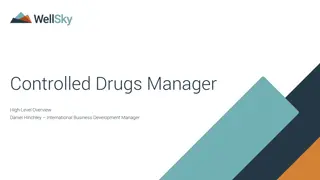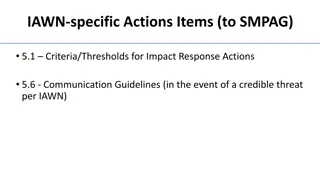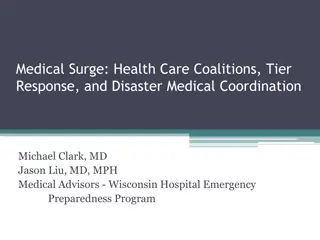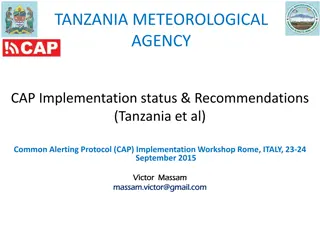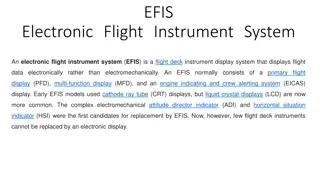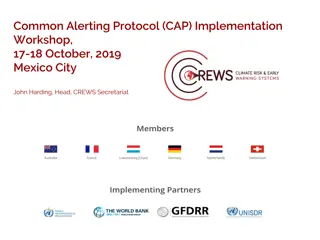Excel with Confidence PCA Linux Foundation Prometheus Certified Associate Exam Mastery
The PCA exam with confidence. Master the Linux Foundation Prometheus Certified Associate certification with comprehensive study materials, practice tests, and expert guidance. Gain the skills and knowledge needed to excel in Prometheus monitoring and alerting. Our resources will help you navigate th
1 views • 5 slides
Netdata - The Open Source Observability Platform: A Comprehensive Overview
Netdata is an open-source observability platform created by Costa Tsaousis. It enables real-time, high-resolution monitoring with auto-discovery of integrations, unsupervised machine learning for metrics, alerting, visualization, and anomaly detection. With easy installation on any system, Netdata p
1 views • 54 slides
Alberta Emergency Management Agency Overview
The Alberta Emergency Management Agency (AEMA) is dedicated to providing strategic leadership in emergency management and business continuity in Alberta. AEMA collaborates with partners and stakeholders to enhance disaster resilience in the region. The agency's structure includes the Managing Direct
3 views • 19 slides
Understanding Zeek: A Comprehensive Workshop Overview
Delve into the intricate world of Zeek with this detailed workshop content, covering topics such as running Zeek from the command line, using Zeek as a daemon, replaying pcaps, Zeek configurations, and alerting setup. Explore practical exercises and outcomes for hands-on learning.
1 views • 30 slides
Leveraging Affordable Technology for Addressing Staffing Challenges in Emergency Services
Discover how automated dispatch processes can help emergency service centers manage dispatcher workload, improve response times, and enhance situational awareness. Learn about the benefits of integrating affordable technology to streamline operations and ensure faster, safer alerting for fire statio
0 views • 14 slides
Understanding the Engine Indicating and Crew Alerting System (EICAS)
An Engine Indicating and Crew Alerting System (EICAS) is an integrated system used in modern aircraft to provide crucial data on engine parameters and other systems to the crew. EICAS, a key feature of glass cockpit systems, categorizes displays and alerts into operational, status, and maintenance m
2 views • 6 slides
Understanding the FDA Audit Process in Research Compliance
The FDA conducts audits to ensure compliance with regulations in research settings. The process involves site notification, preparation, visit, and final determinations. Site preparation includes alerting staff, reserving rooms, ensuring access to necessary equipment, and preparing relevant document
0 views • 17 slides
Understanding Electronic Flight Instrument System (EFIS)
An Electronic Flight Instrument System (EFIS) replaces traditional flight deck instruments with electronic displays like the Primary Flight Display (PFD) and Multi-Function Display (MFD). EFIS enhances situational awareness for pilots by consolidating critical flight data in a single, easy-to-read i
0 views • 12 slides
Performance Based Navigation (PBN) Benefits for General Aviation
Performance Based Navigation (PBN) offers significant benefits for General Aviation, enhancing operational efficiency, route options, and airspace capacity. Through RNAV and RNP specifications, PBN provides improved on-board alerting and monitoring, potentially reducing reliance on ground-based nava
7 views • 13 slides
Health Alert Communication Management Systems
Health Alert Communication Management Systems encompass various workflows and use cases focused on alerting health workers in crisis situations, coordinating care for subjects across health networks, and managing interactions between health workers and clients. The system allows for sending alerts v
0 views • 10 slides
Protective Measures Against Stack Overflows
Host-based defenses such as Canaries, DEP, ASLR, and CFI play a crucial role in safeguarding systems against malicious attacks. Canaries act as early warning systems, alerting to stack overflows by monitoring changes in sensitive data. By implementing stack canaries, developers can prevent buffer ov
0 views • 51 slides
Innovative Biomedical Informatics Research by Dr. Gregory F. Cooper
Dr. Gregory F. Cooper, a distinguished professor of Biomedical Informatics, leads cutting-edge research in applying machine learning, artificial intelligence, and Bayesian statistical methods to solve biomedical informatics challenges. His work includes individualized prediction of treatment effects
0 views • 8 slides
Implementation Experiences of CAP by Kenya Meteorological Department
Kenya Meteorological Department (KMD) has been implementing the Common Alerting Protocol (CAP) since late 2012 to enhance the production and dissemination of weather advisories and warnings. KMD is responsible for generating weather alerts, identifying threat events, and classifying messages based o
0 views • 24 slides
Enhancing IPAWS: Challenges and Opportunities in Public Alert Systems
Exploring the challenges and opportunities in the implementation of the Integrated Public Alert & Warning System (IPAWS) within FEMA. IPAWS-OPEN showcases the current status, advancements, challenges, and future possibilities of the system, emphasizing interoperability issues, outdated systems, and
0 views • 7 slides
Computerized Provider Order Entry (CPOE) and Its Impact on Patient Safety
Computerized Provider Order Entry (CPOE) is a critical component of healthcare technology that automates the patient ordering process to enhance efficiency, reduce medical errors, and improve patient safety outcomes. Integrated with clinical decision support systems, CPOE applies rules-based logic t
0 views • 30 slides
Understanding Service Animals and the ADA Guidelines
The U.S. Department of Justice Civil Rights Division outlines the rules for service animals under the ADA, emphasizing reasonable modifications for individuals with disabilities. The definition is specific to dogs trained to perform tasks for disabled individuals, limiting the species to dogs only.
0 views • 24 slides
Network Monitoring Workshop - Incident Response Overview
This workshop covers various aspects of incident response, including tools and techniques such as network taps, protocol analysis with Wireshark, data summarization with Bro/Zeek, alerting with Snort/Suricata, and more. Sessions delve into topics like TLS inspection, wireless network monitoring, and
0 views • 17 slides
Understanding Federal Public Health Travel Restrictions and Do Not Board Protocol
Delve into the world of Federal Public Health Travel Restrictions, focusing on the Do Not Board (DNB) and Public Health Lookout (PHLO). Learn about the roles of State and Local Health Departments in this process, the history, regulatory authority, and implementation details. Discover how specific cr
0 views • 24 slides
Experiences and Insights from Disaster Preparedness Workshops in Mexico
Explore the aftermath of hurricanes and storms in Baja California Sur, Mexico, and learn about disaster preparedness through workshops and train-the-trainer sessions. Discover the challenges faced, the importance of the Common Alerting Protocol (CAP), and the need to turn experiences into wisdom for
0 views • 23 slides
CAP Implementation Progress in Mali-Meteo and Fast-Tracking in Africa
The Common Alerting Protocol (CAP) implementation in Mali-Meteo by Ismahila Koumare has been significant, with successful alert issuance since 2021. Collaboration with WMO and efforts to fast-track CAP implementation in five African countries show progress and challenges. Mali-Meteo has used cloud-b
0 views • 9 slides
CAP Implementation in Cuba: Experiences and Perspectives for Rapid Progress
José Rubiera, Ph.D., discusses the urgent need for implementing the Common Alerting Protocol (CAP) in Cuba to enhance weather watches and warnings. The challenges faced by the Cuban Meteorological Service are explored, along with plans for CAP implementation in 2020. The overview of Cuba's weather
0 views • 37 slides
Understanding Meteotsunamis: Coastal Hazard Forecasting and Alerting
The SERCOM-3 session focuses on the investigation and guidance regarding weather-driven long waves known as meteotsunamis, emphasizing the need for clarity in terminology and roles in forecasting coastal hazards. The draft decision outlines steps to address this issue and enhance coordination among
0 views • 5 slides
Distillation Safety Scenario: Handling a Cracked Round Bottom Flask
In this distillation safety scenario, you face a cracked round bottom flask leaking amine. Immediate actions involve unplugging the heat source, containing the material, turning on emergency exhaust, and alerting others to evacuate. Preventative measures such as checking for cracks, proper stirring,
0 views • 4 slides
Wireless Public Alerting System in Canada: Update and Challenges
The National Public Alerting System in Canada, operating successfully since 2015, delivers emergency level alerts via various broadcasting methods. Despite its effectiveness, the system faces complaints and challenges, particularly regarding wireless alerts. Issues range from alert timing to the ann
0 views • 20 slides
WellSky CD Manager: Hospital-Wide Controlled Drug Management Platform
WellSky CD Manager offers an innovative, hospital-wide platform for controlled drug management, assisting with compliance, governance, and efficiency. It improves accuracy, adapts to unique hospital environments, and enhances safety through real-time alerting and automated inventory control, ultimat
0 views • 19 slides
Criteria and Thresholds for Impact Response Actions by IAWN/SMPAG
Discussion of criteria and thresholds for impact response actions by IAWN/SMPAG, including warning thresholds based on size and probability of impact, recommendations for terrestrial preparedness planning, and initiation of mitigation mission options. The rationale behind these criteria aims to stri
0 views • 9 slides
Enhancing Healthcare Emergency Preparedness and Response in Wisconsin
The Wisconsin Hospital Emergency Preparedness Program (WHEPP) focuses on supporting hospitals in planning and responding to mass casualty incidents and pandemics. It emphasizes the importance of healthcare coalitions, tier coordination, and disaster medical coordination centers. The program, funded
0 views • 30 slides
Implementation Status and Recommendations for CAP in Tanzania Meteorological Agency
Tanzania Meteorological Agency has successfully implemented the Common Alerting Protocol (CAP) under the Meteorology category, enabling timely dissemination of information to the public through various media channels. Recommendations include protocol adoption, system availability, promotion through
0 views • 20 slides
Understanding Electronic Flight Instrument Systems (EFIS)
An Electronic Flight Instrument System (EFIS) revolutionizes the way flight data is displayed electronically. Consisting of a Primary Flight Display (PFD), Multi-Function Display (MFD), and Engine Indicating and Crew Alerting System (EICAS), EFIS enhances pilot workflow and cockpit efficiency. The t
0 views • 6 slides
Implementing Advanced Server Monitoring and Alerting Techniques
Explore a comprehensive guide covering topics such as custom SNMP trap handling, adding new NRPE checks without restarting, alert strategies based on the day of the week, and efficient monitoring for new *nix mount points. Enhance your server monitoring capabilities with practical solutions and best
0 views • 28 slides
Enhancing Early Warning Systems: The CREWS Initiative in Action
The CREWS Initiative supports Least Developed Countries and Small Island Developing States in building multi-hazard early warning systems to protect lives and assets. Through workshops, training, and capacity building programs, CREWS focuses on improving service delivery, strengthening communication
0 views • 9 slides

